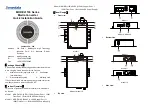
1. Administration
ROS® v3.11User Guide
17
RMC30
Figure 1.6. Administration Menu
1.6. IP Interfaces
These parameters provide the ability to configure IP connection parameters, such as address,
network, and mask. Only one IP interface can be configured.
You can choose from the following IP Address types: Static, DHCP, BOOTP, and Dynamic.
The Static IP Address type refers to the manual assignment of an IP address. The DHCP,
BOOTP, and Dynamic IP Address types refer to the automatic assignment of an IP address.
DHCP is widely used in LAN environments to dynamically assign IP addresses from a
centralized server, which reduces the overhead of administrating IP addresses.
BOOTP is a subset of the DHCP protocol. ROS® supports the transfer of a BOOTFILE via
BOOTP. The BOOTFILE represents any valid ROS® file, such as config.csv. The name of the
BOOTFILE on the BOOTP server must match the corresponding ROS® file.
The Dynamic IP Address type refers to a combination of the BOOTP and DHCP protocols.
Starting with BOOTP, the system tries BOOTP and DHCP in a round-robin fashion until it
receives a response from the corresponding server.
On non-management interfaces, only static IP addresses can be assigned.
On the management interface, the user can choose from the following IP Address types:
Static, DHCP, BOOTP and Dynamic. Static IP Address type refers to the manual assignment
of an IP address while DHCP, BOOTP and Dynamic IP Address types refer to the automatic
assignment of an IP address.
DHCP is widely used in LAN environments to dynamically assign IP addresses from a
centralized server, which reduces the overhead of administrating IP addresses.
















































